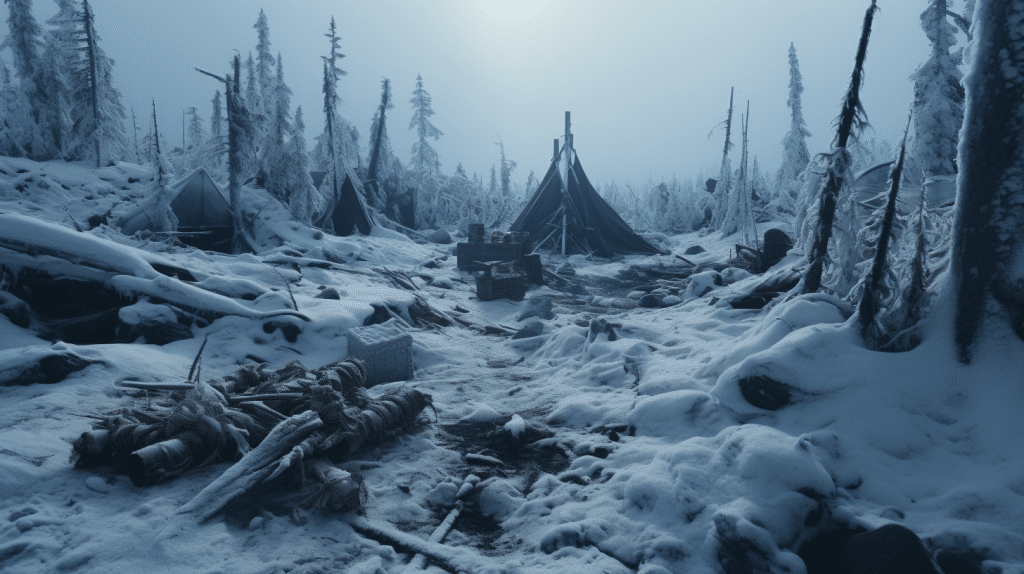The Dyatlov Pass Incident is a mysterious event that occurred on February 2, 1959, in the northern Ural Mountains of Russia. Nine experienced hikers lost their lives under unclear circumstances, leading to numerous theories and speculations. The incident has become a subject of interest for researchers, conspiracy theorists, and true crime enthusiasts alike.

The hikers were part of a group led by Igor Dyatlov, a 23-year-old student at the Ural Polytechnic Institute. The group was on a skiing expedition and had set up camp on the slopes of Kholat Syakhl, which translates to “Dead Mountain.” On the night of February 2, something happened that caused the hikers to cut their way out of their tents and flee into the freezing cold. Search teams found the hikers’ bodies weeks later, scattered in the snow, with signs of severe injuries and unusual circumstances surrounding their deaths.
Despite numerous investigations, the cause of the incident remains a mystery, with many theories ranging from natural disasters to government cover-ups. The Dyatlov Pass Incident has become a cultural phenomenon, inspiring books, documentaries, and even a horror movie.
The Dyatlov Pass Incident

The Dyatlov Pass Incident is a mysterious event that occurred in 1959 in the northern Ural Mountains of Russia. The incident involved the death of nine experienced hikers under uncertain circumstances. The incident is named after the group’s leader, Igor Dyatlov.
The hikers had set up camp on the slopes of Dead Mountain. However, something caused them to abandon their tent in the middle of the night, without proper clothing or supplies. The hikers were found dead several days later, with some of them having sustained injuries consistent with a violent attack.
The cause of their deaths is still unknown, and numerous theories have been proposed over the years. Some theories suggest that the hikers were attacked by a yeti or other mysterious creature, while others suggest that they were killed by members of the military or secret police.
Despite extensive investigations, the true cause of the incident remains a mystery. The incident has captured the imagination of the public and has spawned numerous books, documentaries, and even a Hollywood movie.
The Dyatlov Pass Incident continues to be a topic of interest and speculation, and many people continue to search for answers to this enduring mystery.
The Hikers and Their Journey

The Team
The Dyatlov Pass Incident involved a group of experienced hikers from the Ural Polytechnical Institute in the Soviet Union. Led by Igor Dyatlov, the team consisted of nine members: Yuri Yudin, Lyudmila Dubinina, Semyon Zolotaryov, Yuri Krivonischenko, Yuri Doroshenko, Zinaida Kolmogorova, Rustem Slobodin, and Alexander Kolevatov. The team was on a skiing expedition and had set up camp on the eastern slope of Kholat Syakhl, a mountain in the northern Ural Mountains.
The Expedition
On February 1, 1959, the team began their journey through the Dyatlov Pass, which was then unnamed. As they made their way through the pass, they encountered harsh weather conditions, including snowstorms and low temperatures. Despite the difficult conditions, the team continued their journey towards the base of the mountain.
On the night of February 1, the team set up camp on the slope of Kholat Syakhl. The next day, February 2, the team planned to continue their journey, but something went wrong. The details of what happened next are unclear, but based on the evidence found at the scene, it is believed that the team cut open their tent from the inside and fled into the surrounding wilderness without proper clothing or supplies.
The bodies of the hikers were discovered weeks later, scattered throughout the area. Some of the hikers had died of hypothermia, while others had suffered injuries consistent with a physical attack. The cause of the incident remains a mystery, and many theories have been proposed over the years to explain what happened to the hikers in the Dyatlov Pass.
The Discovery
Search and Find
In February 1959, a search party was sent out to find a group of hikers who had gone missing in the Ural Mountains. The search party found the abandoned campsite of the hikers, which included a tent that had been torn open from the inside. Footprints in the snow led away from the tent and towards the woods. The footprints appeared to be made by people who were not wearing shoes.
Investigation Begins
The investigation into the Dyatlov Pass Incident began immediately after the discovery of the abandoned campsite. Photographs were taken of the scene, and the bodies of the hikers were eventually found. The hikers had died from hypothermia, but the circumstances surrounding their deaths were mysterious. Some of the hikers had injuries that could not be explained by hypothermia, including a fractured skull and broken ribs.
The investigation delved deeper into the events leading up to the deaths of the hikers. Cameras found at the scene provided some clues, including photographs of the hikers setting up camp. The investigation also uncovered a tomb that had been built for the hikers in Sverdlovsk.
Despite the investigation, the Dyatlov Pass Incident remains a mystery. The abandoned campsite and the circumstances surrounding the deaths of the hikers continue to intrigue and puzzle historians and conspiracy theorists alike.
Theories and Explanations

Avalanche Theory
One of the most widely accepted explanations for the Dyatlov Pass Incident is that the hikers were killed by an avalanche. The area where they were camping is known for its dangerous weather conditions, and it is possible that a snow slab or slab avalanche may have occurred, burying the hikers and causing their deaths.
Researchers from the Snow and Avalanche Simulation Laboratory at ETH Zurich, Johan Gaume and Alexander Puzrin, conducted simulations and found that a snowslide could have been triggered by katabatic winds, which are known to occur in the area. The researchers believe that the hikers may have been camping on a slope that was at a high risk of avalanche, and that the noise and force of the snowslide could have caused them to panic and flee their tents in the middle of the night.
Other Theories
Despite the avalanche theory being widely accepted, there are still many other theories and explanations for the Dyatlov Pass Incident. Some conspiracy theories suggest that the hikers were killed by secret government experiments or military testing. Others believe that they were attacked by a yeti or other unknown creature.
While these theories may seem far-fetched, the truth behind the Dyatlov Pass Incident remains a mystery. The hikers’ deaths were tragic and unexpected, and their story has captured the attention of people around the world. As more information is uncovered and new theories are proposed, it is possible that we may one day have a clearer understanding of what happened on that fateful night in 1959.
Mysterious Circumstances

The Dyatlov Pass Incident is a mysterious event that occurred in January 1959, when a group of nine experienced hikers died under mysterious circumstances while trekking through the Ural Mountains in Russia. The incident has puzzled investigators and researchers for more than 60 years, with no clear explanation for what happened.
The hikers were found with various injuries, including hypothermia, undress, and frozen limbs. Some of the hikers were found with paradoxical undressing, a phenomenon where a person experiencing hypothermia may remove their clothes due to a sensation of warmth. Some of the hikers also had chest trauma and head injuries, which are believed to have been caused by a strong force.
The hikers’ mysterious deaths have led to many theories about what happened, including an avalanche, military testing, and even extraterrestrial activity. However, none of these theories have been proven, and the cause of the hikers’ deaths remains a mystery.
Despite the lack of a clear explanation, the Dyatlov Pass Incident continues to fascinate and intrigue people around the world. The mysterious circumstances surrounding the hikers’ deaths have sparked countless theories and speculations, but the truth behind what happened that fateful night may never be fully known.
The Aftermath

The aftermath of the Dyatlov Pass Incident was marked by confusion, speculation, and a lack of clear answers. The Soviet government launched an investigation into the incident, but the results were inconclusive and shrouded in secrecy.
The bodies of the hikers were discovered on the slopes of Kholat Syakhl, also known as Dead Mountain, in the northern Urals. Autopsies revealed that the hikers had died from hypothermia, but some of the injuries sustained by the hikers were unusual and difficult to explain.
The Soviet government initially suggested that the hikers had been killed by an avalanche, but this theory was later called into question. Some investigators pointed to the fact that the hikers’ tent had been torn open from the inside, suggesting that they had fled in a state of panic. Others noted that the hikers’ clothing and equipment had been left behind, indicating that they had left in a hurry and were not properly prepared for the harsh conditions.
The Dyatlov Pass Incident has continued to captivate the public imagination and inspire countless theories and speculations. Some have suggested that the hikers were killed by a secret military weapon or by extraterrestrial beings. Others have argued that the hikers were victims of a natural phenomenon, such as a sudden and unexpected avalanche.
Despite decades of investigation and speculation, the true cause of the Dyatlov Pass Incident remains a mystery. The incident continues to be the subject of intense interest and debate, and it remains one of the most enigmatic and unsettling events in modern history.
Indigenous Mansi People and Their Involvement

The indigenous Mansi people have been associated with the Dyatlov Pass incident since its occurrence. The Mansi people are an indigenous tribe of the region where the incident took place. Early on, Soviet authorities theorized that the Dyatlov party may have been killed by the Mansi. It was believed that the hikers were slaughtered for straying onto sacred land, or perhaps as part of a shamanic ritual.
The Dyatlov party took several photographs of Mansi markings on the trees and wrote several journal entries about them. The markings indicated hunting conditions. Indigenous Mansi in the area led a semi-traditional way of life, hunting, fishing, and herding reindeer.
Despite their hold on tradition, there is no concrete evidence to suggest that the Mansi people were involved in the Dyatlov Pass incident. The Mansi themselves have denied any involvement in the incident.
It is important to note that the Mansi people have been subjected to discrimination and forced assimilation by the Russian government. This has led to a loss of their traditional way of life, language, and culture. Therefore, it is crucial to approach any speculation about their involvement in the Dyatlov Pass incident with sensitivity and respect.
Unusual Findings

The Dyatlov Pass Incident remains a mystery to this day, but recent research has shed new light on some of the unusual findings at the scene. One of the most perplexing aspects of the case was the presence of high levels of radiation on some of the hikers’ clothing. However, it has been suggested that this radiation was likely a result of the hikers’ exposure to natural sources of radiation, such as granite rocks, rather than any kind of military or extraterrestrial activity.
Another strange discovery was the presence of gray foam on the lips of some of the hikers. It has been suggested that this could be a result of pulmonary edema, a condition where fluid builds up in the lungs, causing foam to form in the airways. This could have been caused by the hikers being exposed to extreme cold and high altitude.
Similarly, gray liquid found on the clothing of some of the hikers has been attributed to post-mortem changes, such as the breakdown of hemoglobin in the blood. This is a natural process that occurs after death and can result in the release of fluids from the body.
Scavenging animals have also been suggested as a possible explanation for some of the injuries sustained by the hikers. It is believed that some of the injuries, such as the missing eyes and tongue of some of the hikers, could have been caused by animals scavenging on the bodies after death.
Finally, severe injuries sustained by some of the hikers have been attributed to a variety of causes, including falls and blunt force trauma. It is likely that a combination of factors, such as extreme weather conditions and poor visibility, contributed to the injuries sustained by the hikers.
Overall, while some of the findings at the scene of the Dyatlov Pass Incident remain unexplained, recent research has shed new light on some of the more unusual discoveries.
Modern Interpretations

Over the years, many theories have been put forward to explain the mysterious deaths of the nine hikers at the Dyatlov Pass. Some of the most popular theories include an avalanche, a military cover-up, and even an attack by extraterrestrial beings. However, recent scientific studies have shed new light on the incident, providing a more plausible explanation for what happened that fateful night.
One of the most compelling modern interpretations of the Dyatlov Pass incident is the theory that the hikers were killed by a slab avalanche. A study conducted by scientists from EPFL and ETH Zürich in 2021 suggested that a type of avalanche known as a slab avalanche could explain some of the trekkers’ injuries. The study found that the hikers’ tent was located on a slope that was prone to avalanches, and that a slab avalanche could have caused the injuries that were sustained by some of the hikers.
Another theory that has gained traction in recent years is that the hikers were victims of a military experiment gone wrong. This theory suggests that the Soviet military was conducting secret experiments in the area, and that the hikers stumbled upon one of these experiments. Some proponents of this theory point to the fact that the area was off-limits to civilians at the time, and that the hikers’ bodies were found with high levels of radiation.
Despite these modern interpretations, the Dyatlov Pass incident remains one of the most enduring mysteries of the twentieth century. While scientific studies have provided some possible explanations for what happened that night, the truth may never be fully known.
Steve is the creative force behind My Unique Tales, a blog dedicated to sharing captivating stories that explore the human experience in all its complexity. With a passion for writing and a talent for crafting engaging narratives, Steve's blog is a treasure trove of imaginative tales that transport readers to other worlds and challenge them to see things from new perspectives. From epic adventures to intimate character studies, Steve's stories are always thought-provoking and emotionally resonant. With a growing following of readers who appreciate his unique voice and creative vision, Steve is quickly becoming a rising star in the world of online storytelling.






